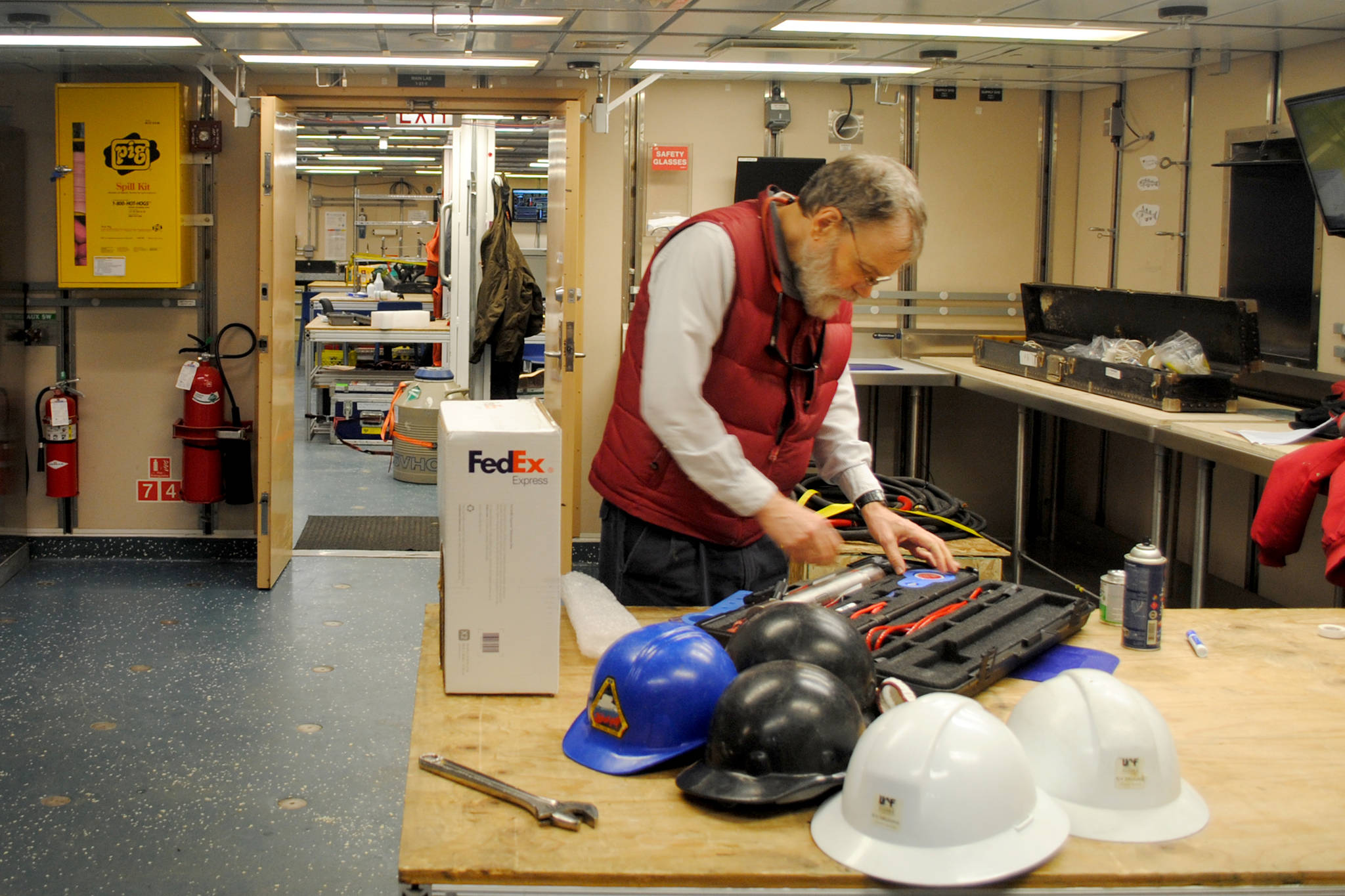After over a month spent docked in Seward, the R/V Sikuliaq set sail last Wednesday.
The vibrant blue-hulled, 261-foot oceanographic research vessel left on a 10-day trip out to the Gulf of Alaska and then down to Seattle, taking a roundabout route to pick up scientific instruments along the way before it pulls into port for a winter of maintenance.
As one of just five global class ships in the University of National Oceanographic Laboratory System, the R/V Sikuliaq, pronounced see-KOO-lee-auk, can be found in waters across the world, but calls Resurrection Bay home.
“The fact that we’re global class allows us to go worldwide,” said Third Mate Arthur Levine, who has been working on the R/V Sikuliaq for nearly three years. “Generally, though, we stay around here to support Alaska research… Some of the other global ships are comparable to us, but they’re not up here as much. They don’t have that inherent Alaska connection, our ability to operate in the Pacific Northwest, and up here in Alaska is our bread and butter.”
Levine has travelled north, south, east and west with the research vessel, spending a majority of the year away from his home in Massachusetts to help facilitate the scientific research conducted with the R/V Sikuliaq. The vessel is owned by the National Science Foundation, but operated by the University of Fairbanks College of Fisheries and Ocean Sciences, which provides logistical support from its office, the UAF Seward Marine Center on Railway Ave.
“They’re our support group … You name it, it’s endless,” said Captain Diego Mello, who has helmed the R/V Sikuliaq for about two years. “They’re one of the most important support mechanisms to keep us rolling, to support science, which is a big deal.”
The vessel hosts a consortium of scientists to conduct research using a wide array of tools on the ship. It was delivered to the crew in 2014, meaning it’s a newer ship with a lot of the bells and whistles.
Although the Sikuliaq isn’t an ice-breaking ship, it’s able to operate through first-year sea ice (ice that has been frozen for a full year) up to 3-feet thick.
The ship is also dynamic positioning capable, meaning the crew can hold position using GPS and a propulsion system to conduct operations within a meter of a specific coordinate, even in otherwise rough weather. The vessel also allows researchers to collect sediment samples with a gravity corer or use the CTD instrument to find conductivity and temperature of the water column (which is housed in a heated room, a welcomed luxury for scientists and crewman operating in Alaska).
“We can set up all sorts of science equipment in our hangar bay,” said Levine. “Scientists love it, especially when it’s nasty outside, you can come in here and avoid all that. The door opens, the crane goes out and collects data then comes back through the door and they work where it’s nice and warm.”
While underway, with cranes moving, nets and moorings being pulled and scientists documenting each step, the back deck of the R/V Sikuliaq gets a bit busy.
“It’s like a ballet,” Levine said. “When we are doing buoy operations or net operations, the bosun (a senioricrew member on deck) will be out here coordinating it all with his head on a swivel. We’re responsible for the safety and deployment of all scientific equipment. The scientists will come to us and tell us how they want it deployed, but we’re the ones responsible for deploying it.”
Away from the vessel’s stern, there are multiple science labs on board with space to make messes, avoid contamination, stay cold, keep hot or whatever else that trip’s research may require.
“Supporting the scientists in all that they do is so important,” Capt. Mello said. “Every mission is new, which is really cool … And most of the folks we have on board are believers in oceanography and science, they want to do the best they can to support the scientist. They enjoy what they do and all the rest is cool.”
Even the simplest of trips on the R/V Sikuliaq are paired with days of preparation.
In his role as Third Mate, Levine focuses on the ship’s safety. From the small, one-bed hospital to each fire extinguisher on board, Levine makes sure the ship is prepared for everything.
“You can’t just run out to an ACE Hardware or call 9-1-1 while your halfway through a 30 day trip in the Arctic,” Levine said. “We have to be prepared for everything.”
As third mate, Levine focuses on the ship’s safety. From the small, one-bed hospital to each fire extinguisher on board, Levine makes sure the ship is ready for anything and everything.
Each trip on the R/V Sikuliaq is unique, but the basic operations are the same and keep safety paramount for all scientists and researchers involved, like Eric D’Asaro of the University of Washington Seattle Applied Physics Laboratory.
“This is actually a very simple trip,” D’Asaro said as he unloaded equipment in one of the science labs on board. “We’re going from here to Seattle via the Northeast Pacific. We’re going to be, well, picking up some stuff and putting some other stuff back in … It’s a very simple cruise.”
To keep tabs on where the R/V Sikuliaq is headed, visit https://www.sikuliaq.alaska.edu/.
Reach Kat Sorensen at ksorensen@peninsulaclarion.com.
• By KAT SORENSEN, Peninsula Clarion

